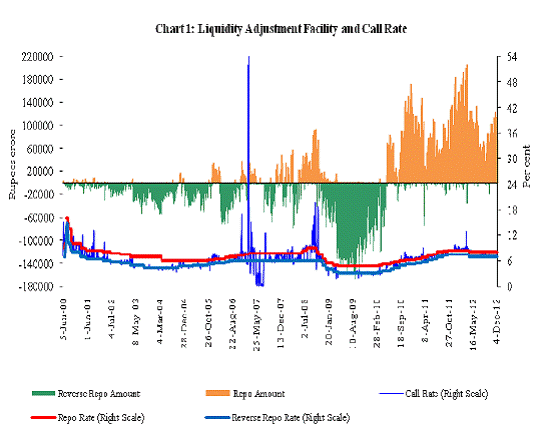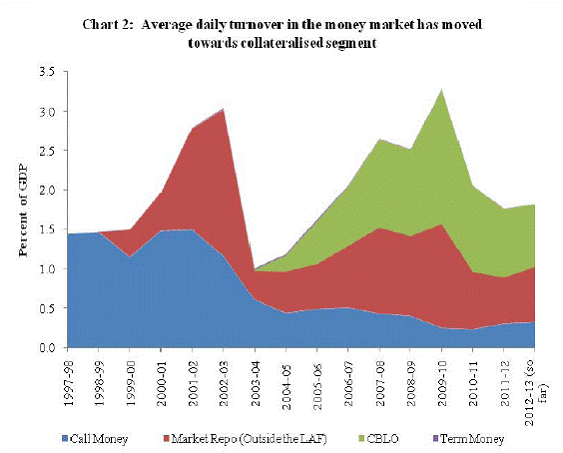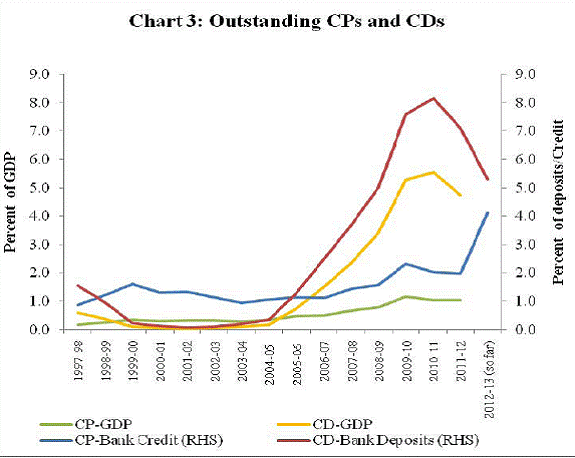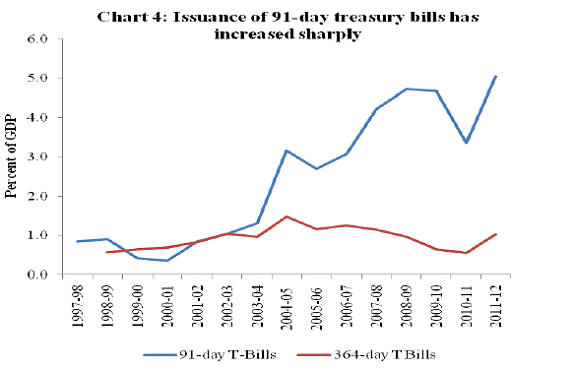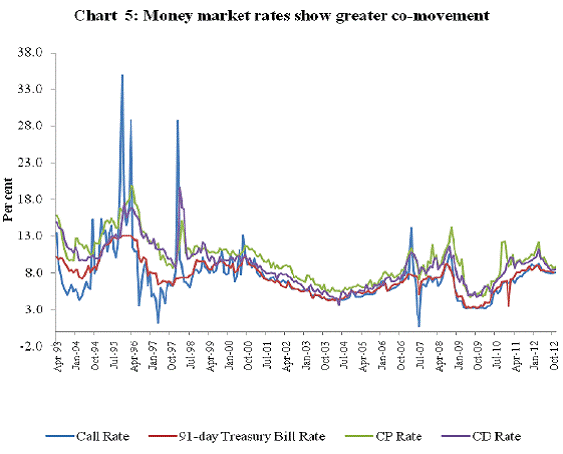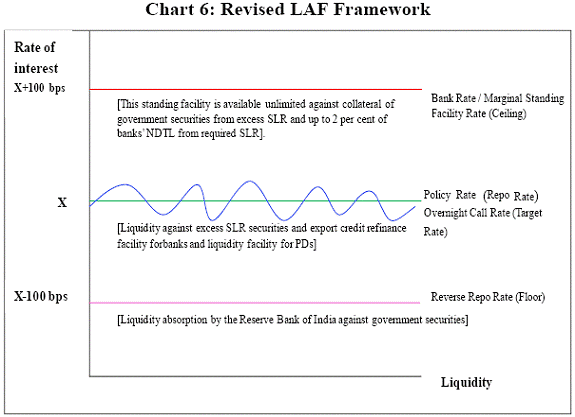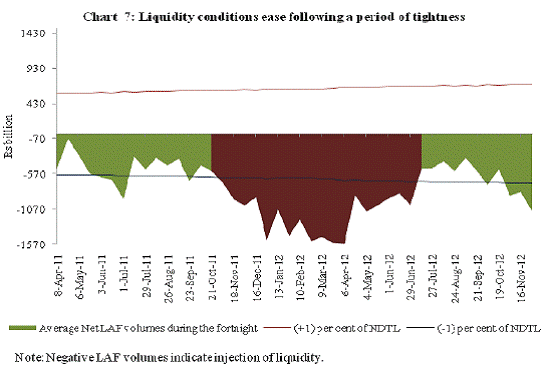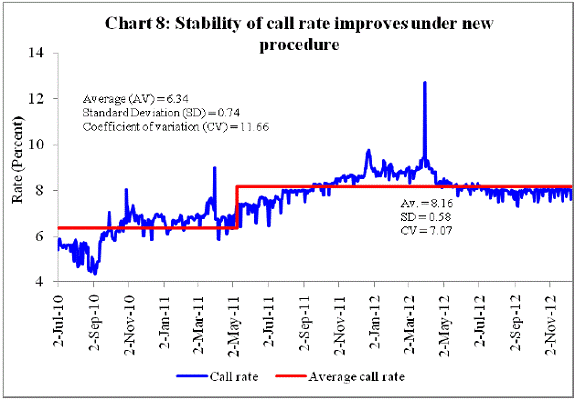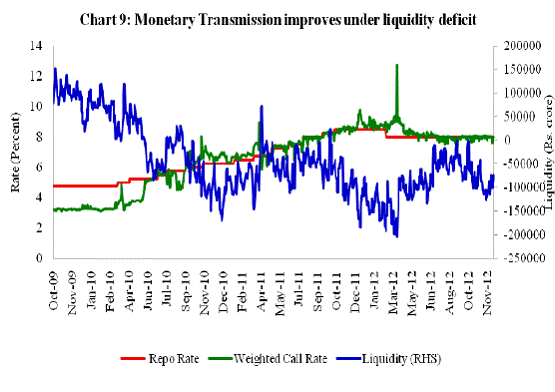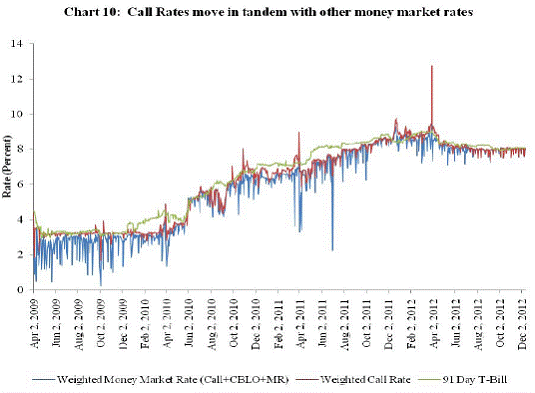 IST,
IST,


Money Market and Monetary Operations in India
Shri Deepak Mohanty, Executive Director, Reserve Bank of India
delivered-on ഡിസം 17, 2012
I thank Mr. G. Mahalingam for the opportunity to share my thoughts in this distinguished panel on money market. This forum which brings together the Reserve Bank and practitioners in the financial market, is important not only from the perspective of market development but also for fostering a better understanding of monetary operations. Money market is at the heart of monetary operations. Over the last decade, there has been substantial development in the Indian money market in terms of depth, variety of instruments and efficiency. This has enabled the Reserve Bank to change its monetary operations from direct quantity based instruments to indirect interest rate based instruments to enhance the efficiency of monetary transmission consistent with international best practice. Against this background, I will briefly capture the developments in the money market and discuss the experience with the recently modified operating procedure of monetary policy before concluding with some thoughts on the way forward. Role of money market Money market can be defined as a market for short-term funds with maturities ranging from overnight to one year and includes financial instruments that are considered to be close substitutes of money. It provides an equilibrating mechanism for demand and supply of short-term funds and in the process provides an avenue for central bank intervention in influencing both the quantum and cost of liquidity in the financial system, consistent with the overall stance of monetary policy. In the process, money market plays a central role in the monetary policy transmission mechanism by providing a key link in the operations of monetary policy to financial markets and ultimately, to the real economy. In fact, money market is the first and the most important stage in the chain of monetary policy transmission. Typically, the monetary policy instrument, effectively the price of central bank liquidity, is directly set by the central bank. In view of limited control over long-term interest rates, central banks adopt a strategy to exert direct influence on short-term interest rates. Changes in the short-term policy rate provide signals to financial markets, whereby different segments of the financial system respond by adjusting their rates of return on various instruments, depending on their sensitivity and the efficacy of the transmission mechanism. How quickly and effectively the monetary policy actions influence the spectrum of market interest rates depends upon the level of development of various segments of financial markets, particularly the money market. Cross-country studies suggest that as domestic financial markets grow, transmission of monetary policy through various channels becomes better. As a crucial initial link in the chain through which monetary policy aims at achieving ultimate goals relating to inflation and growth, money market developments are closely monitored and influenced by central banks. Besides expecting money market rates to respond to policy rate changes in a well anchored manner, central banks aim at ensuring appropriate liquidity conditions through discretionary liquidity management operations so that money market functions normally. Money market is also an important funding market for banks and financial institutions, and at times, even for corporates. Stressed conditions in the money markets could increase moral hazard with banks expecting a central bank to function as the lender of first resort. Following the recent global financial crisis, money market funding for the financial system effectively got replaced with central bank funding in advanced countries. Money market rates (like LIBOR and EURIBOR) are standard benchmarks for pricing of bonds, loans and other financial products. Market manipulation of this key benchmark – as reportedly happened to LIBOR recently - though undermined the faith in money market. A sound money market would have to ensure conditions where banks can conduct business safely. Money market transactions could be both secured and unsecured, i.e., without collaterals. What does one expect from the secured and unsecured markets? The unsecured market should primarily promote market discipline. Loans being uncollateralised in this market, lenders are directly exposed to the risk of non-repayment. This works as an incentive for them to address information asymmetry by collecting information about borrowers. It is the constant peer monitoring that promotes market discipline. In the secured segment of the money market, the lender may address credit risk concerns by asking for sound collaterals and also applying some haircuts, but the peer monitoring could potentially then be less emphasised. Conditions of market stress can lead to collateral scarcity and falling value of collaterals could stifle even the secured money market. Illiquidity spiral from the financial markets, i.e., when financial instruments held as assets turn illiquid, may lead to a situation where central banks would be required to dilute the collateral standards for liquidity injection, and even exchange good quality securities against securities facing illiquidity risks. This becomes necessary to unfreeze the markets in general. After the global crisis, asset quality, particularly liquidity, has received greater policy focus. Money market rates also reflect market expectations of how the policy rate could evolve in the near term. As per standard expectations hypothesis, money market rates for different time duration should equal expected future short-term rates, plus term premium and risk premium. Bernanke (2004)1 had examined how expectations of the likely future course of the federal funds rate respond to the Fed’s policy actions and statements and noted that “...Our findings support the view that FOMC statements have proven a powerful tool for affecting market expectations about the future course of the federal funds rate”. Empirical research suggests that if the shortest end of the money market, which is influenced the most by policy rate, is stable, or less volatile, then it may help in keeping term premium lower, compared to a period when volatile short rates get transmitted to the entire money market and simultaneously the term premium rises. With the sophistication of financial markets rendering the money, output and price relationship unstable, by the early 1980s, major central banks began to emphasise on the price channel, i.e., policy interest rate for monetary policy transmission. As a result, the role of money market became all the more important for signaling and transmission of monetary policy. Thus, the development of money markets across countries in terms of instruments and participants with varying risk profiles has necessitated changes in the operating procedures of monetary policy. In the case of India, the ultimate goals of monetary policy, i.e., price stability and growth, have remained unchanged over the years. In the recent years, financial stability has been considered as an additional objective of monetary policy. However, operational and intermediate objectives of monetary policy have undergone periodic changes in response to changes in the economic and financial environment. The development of the money market over the years and relative stability in the call money market enabled the Reserve Bank to move away from quantity-based instruments to price-based instruments under its multiple indicators approach adopted since 1998. Accordingly, the overnight call rate, which was used implicitly as operating target since the institution of liquidity adjustment facility (LAF) in 2000, became explicit after the adoption of a new operating procedure in May 2011. Money market in India Financial reforms in India began in the early 1990s. However, various segments of domestic financial markets, viz., money market, debt market and forex market underwent significant shifts mainly from the 1990s. Earlier, the Indian money market was characterised by paucity of instruments, lack of depth and distortions in the market micro-structure. It mainly consisted of uncollateralised call market, treasury bills, commercial bills and participation certificates. Following the recommendations of the Chakravarty Committee (1985), the Reserve Bank adopted a monetary targeting framework. At the same time, efforts were made to develop the money market following the recommendations of Vaghul Committee (1987). In this regard, important developments were: (i) setting up of the Discount and Finance House of India (DFHI) in 1988 to impart liquidity to money market instruments and help the development of secondary markets in such instruments; (ii) introduction of instruments such as certificate of deposits (CDs) in 1989 and commercial papers in 1990 and inter-bank participation certificates with and without risk in 1988 to increase the range of instruments; and (iii) freeing of call money rates by May 1989 to enable price discovery. However, the functioning of the market continued to be hindered by a number of structural rigidities such as skewed distribution of liquidity and the prevalence of administered deposit and lending rates of banks. Recognising these rigidities, the pace of reforms in money market was accelerated. Following the recommendations of an Internal Working Group (1997) and the Narasimham Committee (1998), a comprehensive set of measures was undertaken by the Reserve Bank to develop the money market. These included: (i) withdrawal of interest rate ceilings in the money market; (ii) introduction of auctions in treasury bills; (iii) gradual move away from the cash credit system to a loan-based system. Maturities of other existing instruments such as CP and CDs were also gradually shortened to encourage wider participation. Most importantly, the ad hoc treasury bills were abolished in 1997 thereby putting a stop to automatic monetisation of fiscal deficit. This enhanced the instrument independence of the Reserve Bank (Table 1). More importantly, efforts were made to transform the call money market into primarily an inter-bank market, while encouraging other market participants to migrate towards collateralised segments of the market, thereby increasing overall market stability and diversification. In order to facilitate the phasing out of corporate and the non-banks from the call money market, new instruments such as market repos and collateralised borrowing and lending obligations (CBLO) were introduced to provide them avenues for managing their short-term liquidity. Non-bank entities completely exited the call money market by August 2005. In order to minimise the default risk and ensure balanced development of various market segments, the Reserve Bank instituted prudential limits on exposure of banks and primary dealers (PDs) to the call/notice money market. In April 2005, these limits were linked to capital funds (sum of Tier I and Tier II capital) for scheduled commercial banks. In order to improve transparency and efficiency in the money market, reporting of all call/notice money market transactions through negotiated dealing system (NDS) within 15 minutes of conclusion of the transaction was made mandatory. Furthermore, a screen-based negotiated quote-driven system for all dealings in the call/notice and the term money markets (NDS-CALL), developed by the Clearing Corporation of India Limited (CCIL), was operationalised in September 2006 to ensure better price discovery. Beginning in June 2000, the Reserve Bank introduced a full-fledged liquidity adjustment facility (LAF) and it was operated through overnight fixed rate repo and reverse repo from November 2004. This helped to develop interest rate as an important instrument of monetary transmission. It also provided greater flexibility to the Reserve Bank in determining both the quantum of liquidity as well as the rates by responding to the needs of the system on a daily basis (Chart 1).
In the development of various constituents of the money market, the most significant aspect was the growth of the collateralised market vis-à-vis the uncollateralised market. Over the last decade, while the daily turnover in the call money market either stagnated or declined, that of the collateralised segment, market repo plus CBLO, increased manifold (Chart 2). Since 2007-08, both the CP and CD volumes have also increased very significantly (Chart 3). Furthermore, issuance of 91-treasury bills has also increased sharply (Chart 4). The overall money market now is much larger relative to GDP than a decade ago.
Alongside, the rates of return on various instruments in the money market have shown greater co-movement, especially since the introduction of LAF (Table 2 & Chart 5).
Monetary operating procedure The development of money market as well as its growing inter-linkages with other segments of financial markets enabled the Reserve Bank to alter the operating procedures of monetary policy consistent with the objectives of the monetary policy. Based on the recommendations of Chakravarty Committee (1985), a monetary targeting framework with feedback was introduced during the mid-1980s, under which reserve money was used as operating target and broad money (M3) as an intermediate target. By the mid-1990s, this framework was rendered increasingly inadequate due to several developments. Structural reforms and financial liberalisation led to a paradigm shift in the financing of government and commercial sectors with increasingly market-determined interest rates and exchange rate. Development in the various segments of the financial market led to deepening of the financial sector. This provided the Reserve Bank to effectively transmit policy signals through indirect instruments such as interest rates. On the other hand, increase in liquidity emanating from capital inflows raised the ratio of net foreign assets to reserve money and rendered the control of monetary aggregates more difficult. With financial innovations, the stability in the demand function for money also came under question. Recognising these challenges and the growing complexities of monetary management, the Reserve Bank switched to a multiple indicators approach in 1998-99. Under this approach, a host of macroeconomic indicators including interest rates in different segments of financial markets, along with other indicators on currency, lending by banks and financial institutions, fiscal position, trade, capital flows, inflation rate, exchange rate, refinancing and transactions in foreign exchange available on high frequency basis are juxtaposed with output data for drawing implications for monetary policy formulation. However, the approach itself continued to evolve and was further augmented by forward-looking indicators drawn from Reserve Bank’s various surveys and a panel of parsimonious time series models (Mohanty, 2011).2 Along with the multiple indicators approach, operating procedure also underwent a change following the recommendation of Narasimham Committee II (1998). The RBI introduced the Interim Liquidity Adjustment Facility (ILAF) in April 1999, under which liquidity injection was done at the Bank Rate and liquidity absorption was through fixed reverse repo rate. The ILAF gradually transited into a full-fledged liquidity adjustment facility (LAF) with periodic modifications based on experience and development of financial markets and the payment system. The LAF was operated through overnight fixed rate repo and reverse repo from November 2004, which provided an informal corridor for the call money rate. Though the LAF helped to develop interest rate as an instrument of monetary transmission, two major weaknesses came to the fore. First was the lack of a single policy rate, as the operating policy rate alternated between repo during deficit liquidity situation and reverse repo rate during surplus liquidity condition. Second was the lack of a firm corridor, as the effective overnight interest rates dipped (rose) below (above) the reverse repo (repo) rate in extreme surplus (deficit) conditions. Recognising these shortcomings, a new operating procedure was put in place in May 2011. Let me elaborate on the key features of the new operating procedure. First, the weighted average overnight call money rate was explicitly recognised as the operating target of monetary policy.3 Second, the repo rate was made the only one independently varying policy rate. Third, a new Marginal Standing Facility (MSF) was instituted under which scheduled commercial banks (SCBs) could borrow overnight at 100 basis points above the repo rate up to one per cent of their respective net demand and time liabilities (NDTL). This limit was subsequently raised to two per cent of NDTL and in addition, SCBs were allowed to borrow funds under MSF on overnight basis against their excess SLR holdings as well. Moreover, the Bank Rate being the discount rate was aligned to the MSF rate. Fourth, the revised corridor was defined with a fixed width of 200 basis points. The repo rate was placed in the middle of the corridor, with the reverse repo rate at 100 basis points below it and the MSF rate as well as the Bank Rate at 100 basis points above it (Chart 6). Thus, under the new operating procedure, all the three other rates announced by the Reserve Bank, i.e., reverse repo rate, MSF rate and the Bank Rate, are linked to the single policy repo rate.
The new operating procedure was expected to improve the implementation and transmission of monetary policy for the following reasons. First, explicit announcement of an operating target makes market participants clear about the desired policy impact. Second, a single policy rate removes the confusion arising out of policy rate alternating between the repo and the reverse repo rates, and makes signalling of monetary policy stance more accurate. Third, MSF provides a safety valve against unanticipated liquidity shocks. Fourth, a fixed interest rate corridor set by MSF rate and reverse repo rate, reduces uncertainty and communication difficulties and helps keep the overnight average call money rate close to the repo rate. Let me now turn to a brief evaluation of the experience with the new operating procedure. In the implementation of the new procedure, the Reserve Bank prefers to keep the systemic liquidity in deficit mode as monetary transmission is found to be more effective in this situation (RBI, 2011).4 The Reserve Bank also announced an indicative liquidity comfort zone of (+)/(-) 1.0 per cent of net demand and time liabilities (NDTL) of banks. Since May 2011, the liquidity conditions can be broadly divided into three distinct phases. After generally remaining within the Reserve Bank’s comfort zone during the first phase during May-October 2011, the liquidity deficit crossed the one per cent of NDTL level during November 2011 to June 2012. This large liquidity deficit was mainly caused by forex intervention and increased divergence between credit and deposit growth. The deficit conditions were further aggravated by frictional factors like the build-up of government cash balances with the Reserve Bank that persisted longer than anticipated and the increase in currency in circulation. Accordingly, the Reserve Bank had to actively manage liquidity through injection of liquidity by way of open market operations (OMOs) and cut in cash reserve ratio (CRR) of banks. This was supported by decline in currency in circulation and a reduction in government cash balances with the Reserve Bank. As a result, there was a significant easing of liquidity conditions since July 2012 with the extent of the deficit broadly returning to the Reserve Bank’s comfort level of one per cent of NDTL (Chart 7).
Since its implementation, the systemic liquidity has been in deficit mode, which has helped in better transmission of policy rate to various segments of money markets. First, the overnight interest rate has been more stable since its implementation (Chart 8).
Second, the repo rate and weighted call rate are far more closely aligned under the new operating procedure than earlier; implying improved transmission of monetary policy in terms of movement in call money market interest rate (Chart 9).
Third, the call money rate in turn is observed to be better aligned with other money market interest rates after the implementation of new operating procedure than before (Chart 10).
Conclusion Let me conclude. Our experience shows that the development of money market and refinements in operating procedures of monetary policy have moved in tandem. Financial sector reforms along with Reserve Bank’s emphasis on development of various segments of financial market enabled shifts in operating procedures based on direct quantity-based instruments to indirect interest rate-based instruments. The Reserve Bank has been able to better transmit monetary policy signals in the money market through a single policy repo rate. Evidence so far suggests a significant improvement in monetary policy transmission under the new operating framework. In order to reinforce this process, I make three suggestions. First, there has been a swift transmission of policy rate at the short-end of money market, partly due to the prevalence of market liquidity in deficit mode. However, ensuring market liquidity in a deficit mode of desired level on a sustained basis is contingent on Reserve Bank’s ability to effectively conduct OMOs and the market appetite for such operations. Hence, there is a need to develop the market micro-structure and further enhance secondary market transactions in government securities to facilitate smooth conduct of OMOs. Second, the LAF is not the appropriate instrument for managing the liquidity of more enduring nature. As the system is expected to be in deficit, there is a need to develop term repo to minimise daily requirement of liquidity. Third, notwithstanding significant advances in developing the market, the term structure in the money market is incomplete. It is, therefore, desirable to extend the yield curve beyond the overnight rate by developing a term-money market. Thank you.* Speech by Shri Deepak Mohanty, Executive Director, Reserve Bank of India, at the Seminar on Issues in Financial Markets, Mumbai, 15th December 2012. The assistance provided by Sitikantha Pattanaik, Jeevan Khundrakpam, Binod Bhoi and Rajeev Jain is acknowledged. 1 Bernanke, Ben S. (2004), “Central Bank Talk and Monetary Policy”, At the Japan Society Corporate Luncheon, New York, October 7. 2 Mohanty, Deepak (2010), “Monetary Policy Framework in India: Experience with Multiple-Indicators Approach”, RBI Bulletin, March 2010. 3 Even though the share of call money market in the overnight money market is lower than that of collateralised segment, the weighted overnight call rate is used as operating target. This is partly on account of high correlation between the overnight call money rate and the collaterallised money market rate at 0.9. The issue was examined in detail by the Working Group on Operating Procedure of Monetary Policy which observed that the transmission of policy rate to the overnight call money rate is stronger than the overnight money market rate. In addition, the call money market is a pure inter-bank market and, hence, better reflects the net liquidity situation. 4 Reserve Bank of India (2011), Report of the Working Group on Operating Procedure of Monetary Policy (Chairman: Deepak Mohanty), March. |
|||||||||||||||||||||||||||||||||||||||||||||||||||||||||||||||||||||||||||||||||||||||||||||||||||||||||||||||||||||||||||||||||||||||||||||||||||||||||||||||||||||
പേജ് അവസാനം അപ്ഡേറ്റ് ചെയ്തത്:






